
Shifting the Paradigm™ Changing the speed of trait development & deployment NOVEMBER 2023
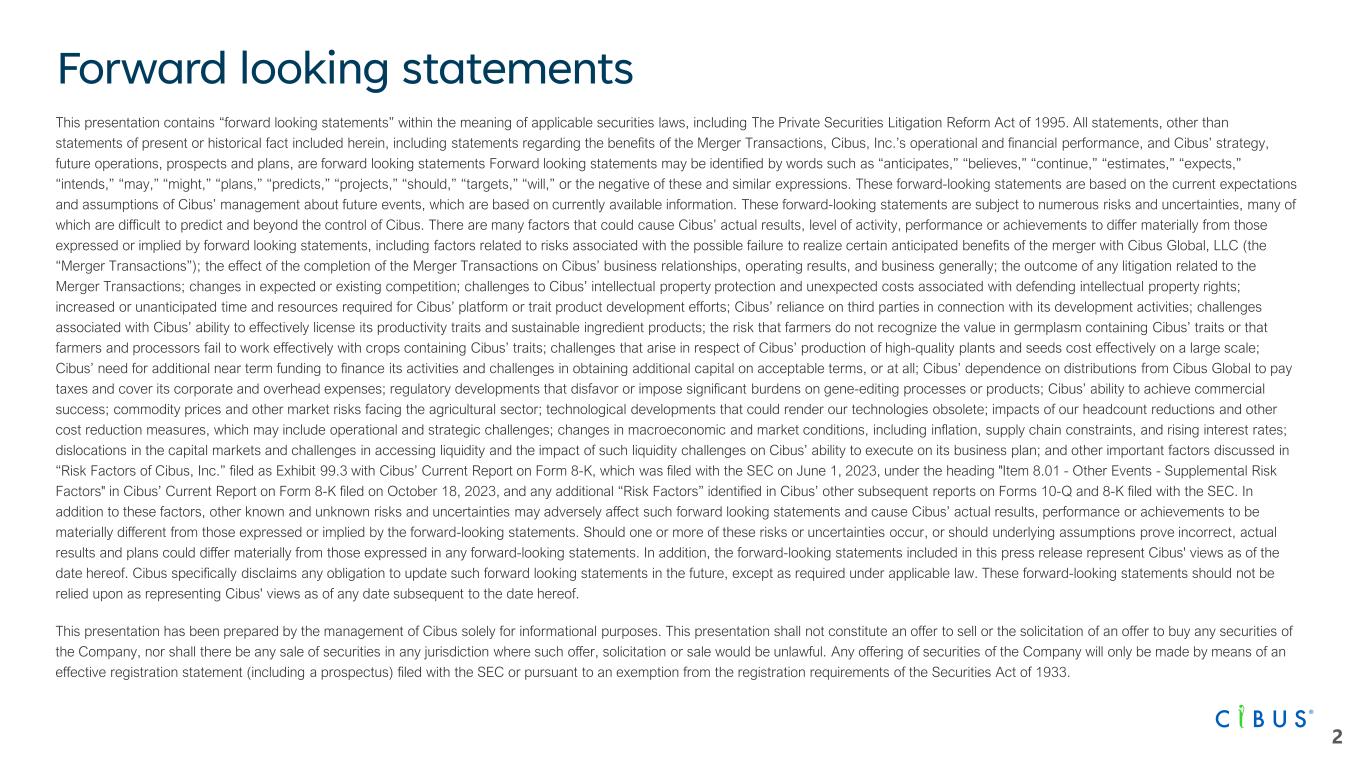
This presentation contains “forward looking statements” within the meaning of applicable securities laws, including The Private Securities Litigation Reform Act of 1995. All statements, other than statements of present or historical fact included herein, including statements regarding the benefits of the Merger Transactions, Cibus, Inc.’s operational and financial performance, and Cibus’ strategy, future operations, prospects and plans, are forward looking statements Forward looking statements may be identified by words such as “anticipates,” “believes,” “continue,” “estimates,” “expects,” “intends,” “may,” “might,” “plans,” “predicts,” “projects,” “should,” “targets,” “will,” or the negative of these and similar expressions. These forward-looking statements are based on the current expectations and assumptions of Cibus’ management about future events, which are based on currently available information. These forward-looking statements are subject to numerous risks and uncertainties, many of which are difficult to predict and beyond the control of Cibus. There are many factors that could cause Cibus’ actual results, level of activity, performance or achievements to differ materially from those expressed or implied by forward looking statements, including factors related to risks associated with the possible failure to realize certain anticipated benefits of the merger with Cibus Global, LLC (the “Merger Transactions”); the effect of the completion of the Merger Transactions on Cibus’ business relationships, operating results, and business generally; the outcome of any litigation related to the Merger Transactions; changes in expected or existing competition; challenges to Cibus’ intellectual property protection and unexpected costs associated with defending intellectual property rights; increased or unanticipated time and resources required for Cibus’ platform or trait product development efforts; Cibus’ reliance on third parties in connection with its development activities; challenges associated with Cibus’ ability to effectively license its productivity traits and sustainable ingredient products; the risk that farmers do not recognize the value in germplasm containing Cibus’ traits or that farmers and processors fail to work effectively with crops containing Cibus’ traits; challenges that arise in respect of Cibus’ production of high-quality plants and seeds cost effectively on a large scale; Cibus’ need for additional near term funding to finance its activities and challenges in obtaining additional capital on acceptable terms, or at all; Cibus’ dependence on distributions from Cibus Global to pay taxes and cover its corporate and overhead expenses; regulatory developments that disfavor or impose significant burdens on gene-editing processes or products; Cibus’ ability to achieve commercial success; commodity prices and other market risks facing the agricultural sector; technological developments that could render our technologies obsolete; impacts of our headcount reductions and other cost reduction measures, which may include operational and strategic challenges; changes in macroeconomic and market conditions, including inflation, supply chain constraints, and rising interest rates; dislocations in the capital markets and challenges in accessing liquidity and the impact of such liquidity challenges on Cibus’ ability to execute on its business plan; and other important factors discussed in “Risk Factors of Cibus, Inc.” filed as Exhibit 99.3 with Cibus’ Current Report on Form 8-K, which was filed with the SEC on June 1, 2023, under the heading "Item 8.01 - Other Events - Supplemental Risk Factors" in Cibus’ Current Report on Form 8-K filed on October 18, 2023, and any additional “Risk Factors” identified in Cibus’ other subsequent reports on Forms 10-Q and 8-K filed with the SEC. In addition to these factors, other known and unknown risks and uncertainties may adversely affect such forward looking statements and cause Cibus’ actual results, performance or achievements to be materially different from those expressed or implied by the forward-looking statements. Should one or more of these risks or uncertainties occur, or should underlying assumptions prove incorrect, actual results and plans could differ materially from those expressed in any forward-looking statements. In addition, the forward-looking statements included in this press release represent Cibus' views as of the date hereof. Cibus specifically disclaims any obligation to update such forward looking statements in the future, except as required under applicable law. These forward-looking statements should not be relied upon as representing Cibus' views as of any date subsequent to the date hereof. This presentation has been prepared by the management of Cibus solely for informational purposes. This presentation shall not constitute an offer to sell or the solicitation of an offer to buy any securities of the Company, nor shall there be any sale of securities in any jurisdiction where such offer, solicitation or sale would be unlawful. Any offering of securities of the Company will only be made by means of an effective registration statement (including a prospectus) filed with the SEC or pursuant to an exemption from the registration requirements of the Securities Act of 1933. Forward looking statements 2

Introduction Background 3

Rory Riggs CEO, Chairman Co-Founder Peter Beetham PhD COO, President Co-Founder Greg Gocal PhD EVP, Chief Scientific Officer, Co-founder Noel Sauer PhD SVP, Head of R&D Wade King MD Chief Financial Officer Steve Berreth JD General Counsel Experienced management team 4

Technology Trait Company Business Model 2001 FOUNDED High Throughput Gene Edited Breeding First standardized, semi-automated gene editing breeding system Analog to digital type change in breeding Over 400 issued and pending patents Develops Productivity Traits Plant traits that improve productivity of seeds for farmers. Sustainable Ingredients Developed through partner-funded projects. Licenses Traits for Royalties Develop - License Crop Traits 5 Trait Pipeline | 3 Major Crops Customers 185 APPROX. EMPLOYEES San Diego, CA HEADQUARTERS Highlights A leader in gene editing in agriculture 5See Slide 26 for Certain Definitions and Endnote (b) beginning on Slide 27 for important information, including the definition of “customers” as used throughout this presentation.

Trait Co’s are part of the seed industry Cibus’ traits are patented genetics that make seeds more productive for farmers Seed Co’s pay Trait Co’s royalties for traits with productivity gains/cost savings Seeds For hundreds of millions of acres Fertilizers Crop protection Growers ConsumersConsumer goods companies Ag commodity traders / processors Seeds Germplasm Traits 1 2 4 Ag Inputs Chemicals Fertilizers Fungicides Herbicides Insecticides 6 The Model 3

We believe that Seed Co’s & Trait Co’s are the leaders in addressing agriculture’s productivity challenge 1970 1980 1990 2000 2010 2020 2030 2040 2050 Maize Rice Wheat Soybean Required Yield for Sustainability Projected Yield 7

Unprecedented Speed & Scale of Trait Development Cibus Enables Trait Development in Years vs. Decades Gene Editing is Agriculture’s “analog to digital” moment The Big Idea Cibus Trait Machine Conventional Trial Development GMO Breeding APPROX. 12–15 YRS APPROX. 3–5 YRS Trait Machine System 8 APPROX. 16.5 YRS.(1) $115M AVG. COST (1) Crop Life International, Philips McDougal Study (2021)

Pipeline 1 PSR* 2 HT1* 3 HT2 4 HT3* 5 Sclerotinia *Developed Key Technologies Target Products Single Cell Regeneration Ability to Edit Elite Germplasm ODM Ability to do Complex Traits Production Scale & Speed DISEASE CLIMATE AGRONOMYFERTILIZER WEED PESTS TAKE ~3 – 5 YEARS TO DEVELOP Productivity Traits Earn Trait Royalties Traits Drive the productivity & profitability of farmers, increasing yields Key technologies Create traits in plants that are Licensed to Seed Co’s for Royalties Target products Traits to manage Yield, Weeds, Disease, Fertilizer Use, Pests & the Environment 9
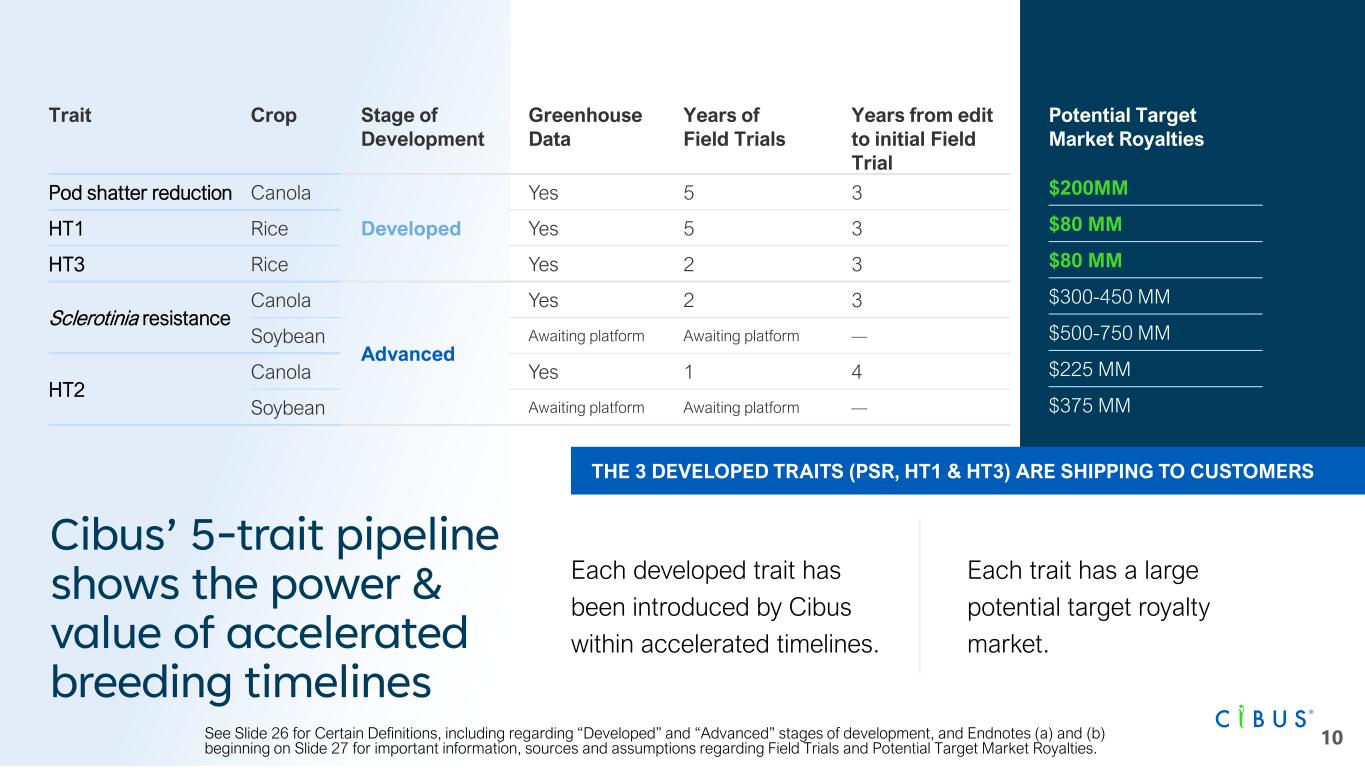
Cibus’ 5-trait pipeline shows the power & value of accelerated breeding timelines THE 3 DEVELOPED TRAITS (PSR, HT1 & HT3) ARE SHIPPING TO CUSTOMERS Trait Crop Stage of Development Greenhouse Data Years of Field Trials Years from edit to initial Field Trial Pod shatter reduction Canola Developed Yes 5 3 HT1 Rice Yes 5 3 HT3 Rice Yes 2 3 Sclerotinia resistance Canola Advanced Yes 2 3 Soybean Awaiting platform Awaiting platform — HT2 Canola Yes 1 4 Soybean Awaiting platform Awaiting platform — Potential Target Market Royalties $200MM $80 MM $80 MM $300-450 MM $500-750 MM $225 MM $375 MM Each developed trait has been introduced by Cibus within accelerated timelines. 10 Each trait has a large potential target royalty market. See Slide 26 for Certain Definitions, including regarding “Developed” and “Advanced” stages of development, and Endnotes (a) and (b) beginning on Slide 27 for important information, sources and assumptions regarding Field Trials and Potential Target Market Royalties.

Cibus has 3 traits that are developed & shipping 1st Developed Trait | PSR 2nd Developed Traits | HT1 & HT3 LA U N C H P R O G R E S S LA U N C H P R O G R E S S Transferred back Transferred by Year End 2023 10 Initial customers APPROX. 20M Accessible Customer Acres 10 Germplasms edited ALL ~$150M Potential Initial Customer Royalties 2 Up to 6 Initial edit returned RICE 3 Customers APPROX. 3M Accessible Customer Acres ~$70M Potential Initial Customer Royalties CANOLA 11 EACH TRAIT HAS A STRONG BASE OF CUSTOMERS | POTENTIAL TARGET MARKET ROYALTIES > $300 MILLION See Slide 26 for Certain Definitions and Endnotes (b) and (c) beginning on Slide 27 for important information, sources and assumptions regarding Potential Target Market Royalties and Potential Initial Customer Royalties. Nutrien Remaining Customers Year End 2023

The 1st Gene Edited Disease Trait Major Disease for Canola & Soybean Estimated Trait Fees: $10-$15 per acre Potential Target Market Royalties (Canola & Soybean) > $1 B Trait for Needed Novel Broadleaf Herbicide Important in Canola & Soybean Greenhouse Data Expected Summer 2024 Estimated Trait Fees: $5-$12 per acre Potential Target Market Royalties (Canola & Soybean) ~ $600 MM SCLEROTINIA RESISTANCE HT2 12 Soybean: Expect System for “Single Cell Regeneration to a Plant”— Edits Expected in Q4 2023 Cibus has two advanced soybean traits with Potential Target Market Royalties > $500 million See Slide 26 for Certain Definitions and Endnote (b) beginning on Slide 27 for important information, sources and assumptions regarding Estimated Trait Fees and Potential Target Market Royalties. Soybean Crop follows Rice & Canola 200 M+ Accessible Acres

What are Cibus’ Key Drivers? 13
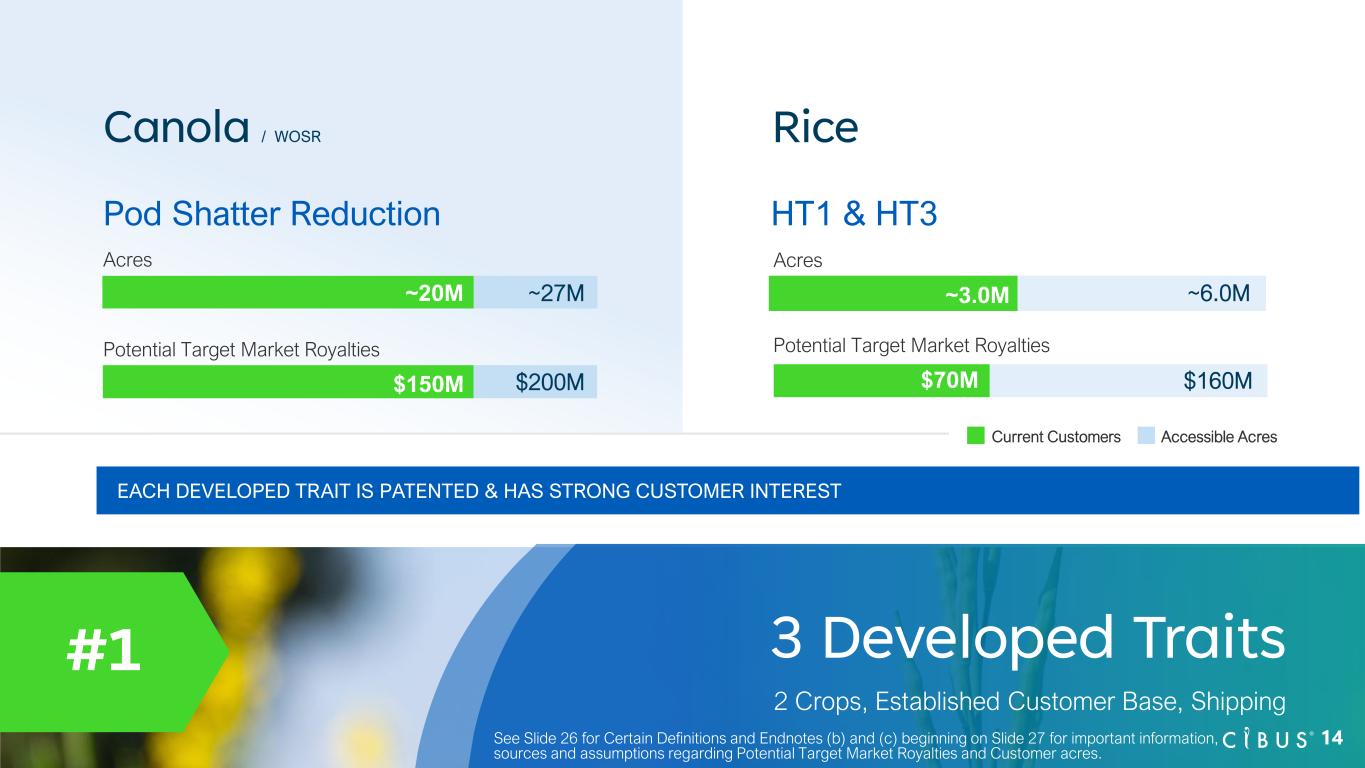
EACH DEVELOPED TRAIT IS PATENTED & HAS STRONG CUSTOMER INTEREST Pod Shatter Reduction HT1 & HT3 Current Customers Accessible Acres Canola / WOSR Rice Acres Potential Target Market Royalties $150M $200M ~20M ~27M Acres ~3.0M ~6.0M Potential Target Market Royalties $70M $160M 3 Developed Traits 2 Crops, Established Customer Base, Shipping #1 14See Slide 26 for Certain Definitions and Endnotes (b) and (c) beginning on Slide 27 for important information, sources and assumptions regarding Potential Target Market Royalties and Customer acres.

3 Crop Platforms 3 Single Cell Regeneration Systems, Multiple Traits, Established Customers Soybean Est. Q4 2023* TRAITS 250M 2 ACRES Rice Operational TRAITS TRAIT PLATFORM 15M 2 ACRES Operational Canola / WOSR Total Market Trait Pipeline ACRES TRAITS TRAIT PLATFORM 50M 3 TO COME * Cibus’ Soybean Single Cell Regeneration to Plant System is not operational. Initial edits are expected to be initiated in 2023, with the system fully operational in 2024 with regeneration of the single cell into a whole plant. See Slide 25 for Certain Definitions and Endnotes (b) and (c) on Slides 26-28 for important information, sources and assumptions regarding Total Market Acres. #2 *SOYBEAN SYSTEM EXPECTED FULLY OPERATIONAL (WITH EDITED CELL REGENERATED INTO FULL PLANT) - EXP. 2024 15
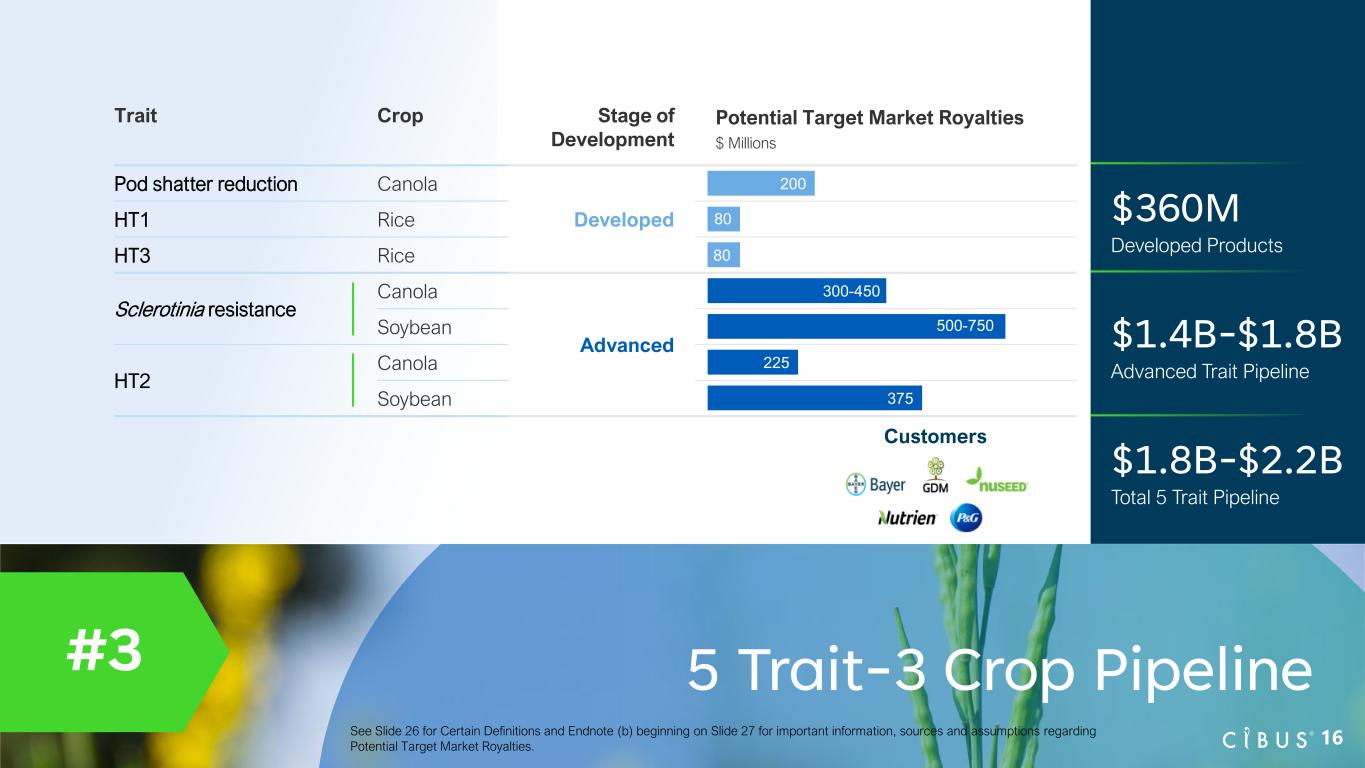
#3 Trait Crop Stage of Development Potential Target Market Royalties $ Millions Pod shatter reduction Canola DevelopedHT1 Rice HT3 Rice Sclerotinia resistance Canola Advanced Soybean HT2 Canola Soybean 375 225 500-750 300-450 80 80 200 5 Trait-3 Crop Pipeline 16See Slide 26 for Certain Definitions and Endnote (b) beginning on Slide 27 for important information, sources and assumptions regarding Potential Target Market Royalties. $360M Developed Products $1.4B-$1.8B Advanced Trait Pipeline $1.8B-$2.2B Total 5 Trait Pipeline Customers
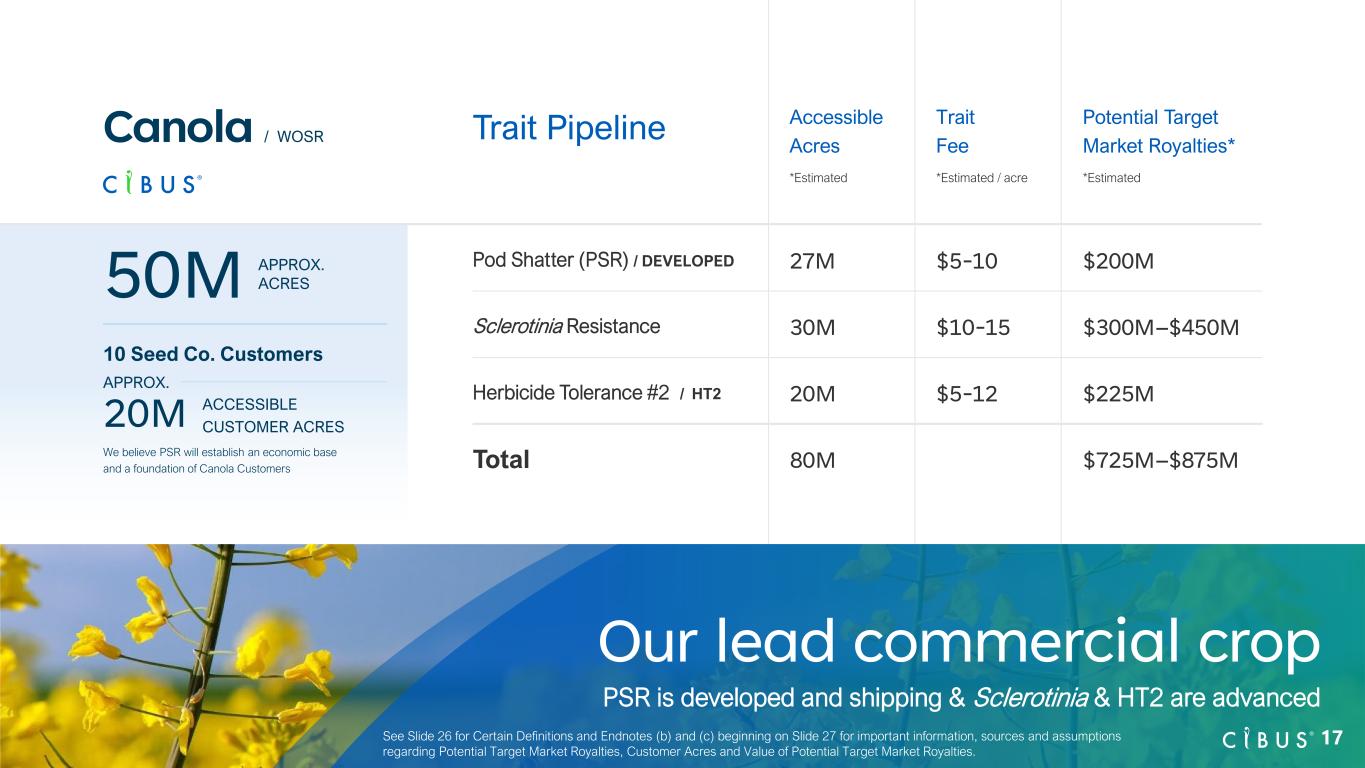
Trait Pipeline Accessible Acres *Estimated Trait Fee *Estimated / acre Potential Target Market Royalties* *Estimated Pod Shatter (PSR) / DEVELOPED 27M $5-10 $200M Sclerotinia Resistance 30M $10-15 $300M–$450M Herbicide Tolerance #2 / HT2 20M $5-12 $225M Total 80M $725M–$875M APPROX. ACRES50M 10 Seed Co. Customers We believe PSR will establish an economic base and a foundation of Canola Customers APPROX. 20M Our lead commercial crop PSR is developed and shipping & Sclerotinia & HT2 are advanced Canola / WOSR 17See Slide 26 for Certain Definitions and Endnotes (b) and (c) beginning on Slide 27 for important information, sources and assumptions regarding Potential Target Market Royalties, Customer Acres and Value of Potential Target Market Royalties. ACCESSIBLE CUSTOMER ACRES
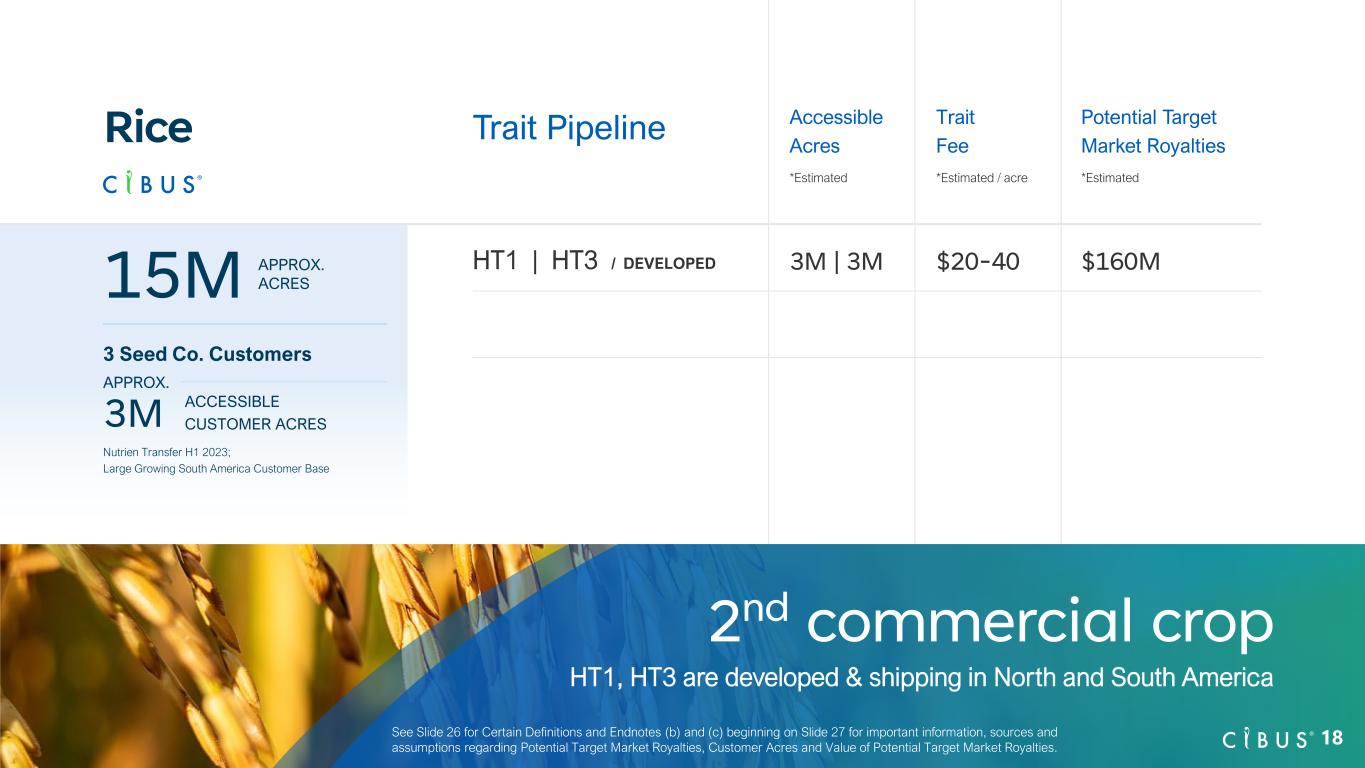
Trait Pipeline Accessible Acres *Estimated Trait Fee *Estimated / acre Potential Target Market Royalties *Estimated HT1 | HT3 / DEVELOPED 3M | 3M $20-40 $160M 2nd commercial crop HT1, HT3 are developed & shipping in North and South America APPROX. ACRES15M 3 Seed Co. Customers Nutrien Transfer H1 2023; Large Growing South America Customer Base APPROX. 3M Rice 18See Slide 26 for Certain Definitions and Endnotes (b) and (c) beginning on Slide 27 for important information, sources and assumptions regarding Potential Target Market Royalties, Customer Acres and Value of Potential Target Market Royalties. ACCESSIBLE CUSTOMER ACRES

APPROX. ACRES250M Customer relationship with GDM, a key leading soybean Seed Co with large acreage 3rd commercial crop Sclerotinia & HT2 are advanced and will be launched in Canola first Trait Pipeline Accessible Acres *Estimated Trait Fee *Estimated / acre Potential Target Market Royalties *Estimated Sclerotinia Resistance 50M $10-15 $500M-750M Herbicide Tolerance #2 / HT2 75M $5-12 $375 Total 125M $875M-$1,125M 19 Cibus’ Soybean Single Cell Regeneration to Plant System is not yet operational. Initial edits are expected to be initiated in Q4 2023, with the system fully operational in 2024 with regeneration of the single cell into a whole plant. Soybean See Slide 26 for Disclaimers and Certain Definitions and Endnotes (b) and (c) beginning on Slide 27 for important information, sources and assumptions regarding Potential Target Market Royalties, Customer Acres and Value of Potential Target Market Royalties.

Bt Traits are traits that reduce acres lost The Bt trait is a great example of the value generated from these type of traits Bt trait example Used on: CROP Corn Cotton Soy TRAIT FEES $2.6B $0.7B $0.5B >300M Note: Bt Trait is presented as an example. It is not owned by Cibus. It is owned and licensed by several seed companies * Trait Fee acreage information are 2020 estimates based on data from Agbioinvestor, US Gov., BCG & 3rd party consultants. Source USDA, Traits are predominantly GMO traits in North & South America. See slide 26 for certain definitions. ACRES Bt trait market HIGH PER ACRE TRAIT FEES $10-$20 APPROX. ANNUAL TRAIT FEES $4B Crop by crop 2020 est. EXAMPLE | “Bt TRAITS” FEES BASED ON LOWER LOSSES DUE TO PESTS TRAIT FREE ACRES >300MCORN ROOTWORM COTTON BELLWOOD SOYBEAN LOOPER 20

Sclerotinia Fees are also expected to be based on acres lost Critically needed trait as infection rates can be as high as 90% Important in both canola & soybean Cost of Fungicide $20-$30 per acre Crop loss due to Sclerotinia % of crop infected % yield loss from infection $Value (per acre) of yield loss from infection* Potential trait fee per acre 10% 5% $30 $10 20% 10% $60 $20 30% 15% $90 $30 40% 20% $120 $40 Fungicide Breakeven SCLEROTINIA TRAIT FEE WILL BE BASED ON ITS DIRECT IMPACT ON ACRES LOST TO THE DISEASE Assumption: $16.11 per bushel (50 pounds), 37.9 bushels per acre, Trait Fee Potential equals 1/3 of $ Value of Loss to Farmer. CANOLA (Estimated Impacted Acres: ~30 MM) 21*Note: Average annual per acre fungicide cost for Canola is from Farm Progress (FarmProgress.com). Other Sources: Canola Council of Canada at https://www.canolacouncil.org/canola-encyclopedia/diseases/sclerotinia-stem-rot/.

Where is all this going? 22
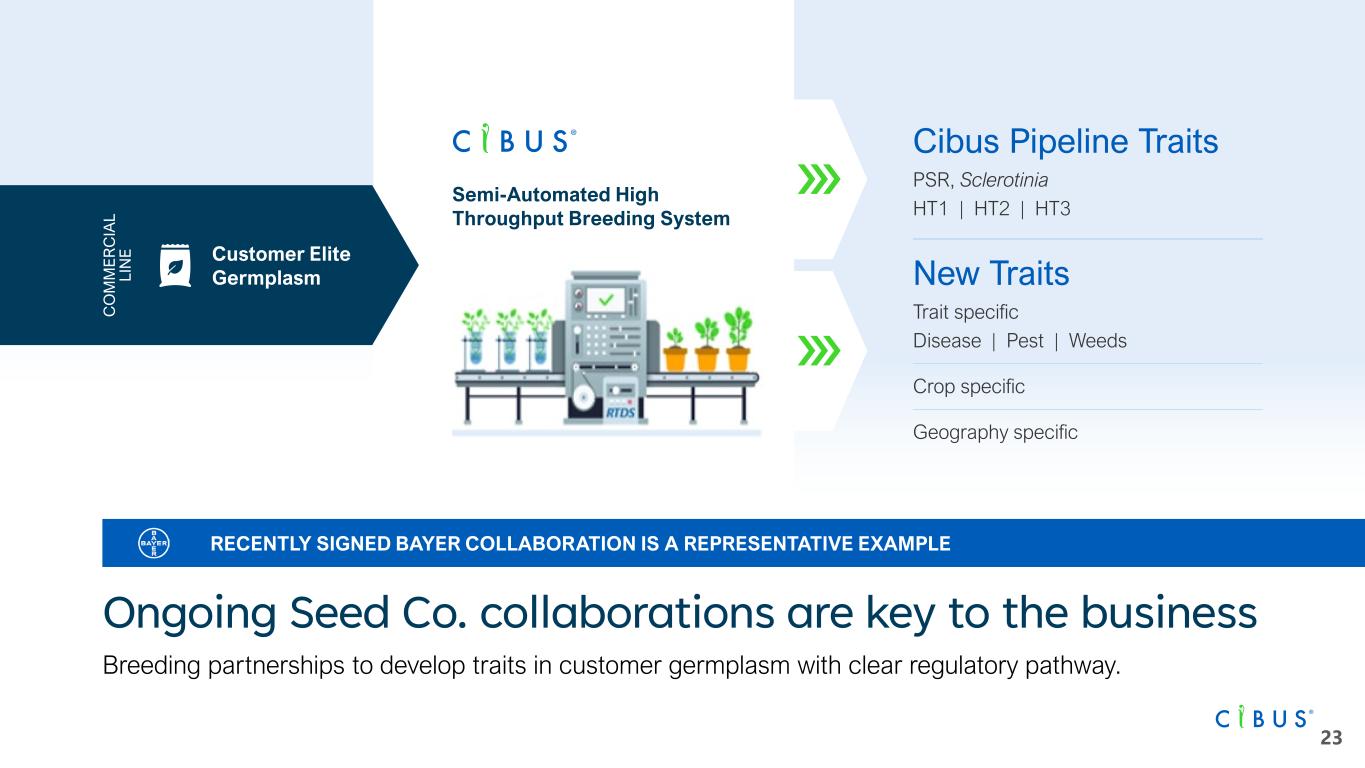
Ongoing Seed Co. collaborations are key to the business Breeding partnerships to develop traits in customer germplasm with clear regulatory pathway. Customer Elite Germplasm C O M M E R C IA L LI N E RECENTLY SIGNED BAYER COLLABORATION IS A REPRESENTATIVE EXAMPLE Cibus Pipeline Traits PSR, Sclerotinia HT1 | HT2 | HT3 New Traits Trait specific Disease | Pest | Weeds Crop specific Geography specific Semi-Automated High Throughput Breeding System 23
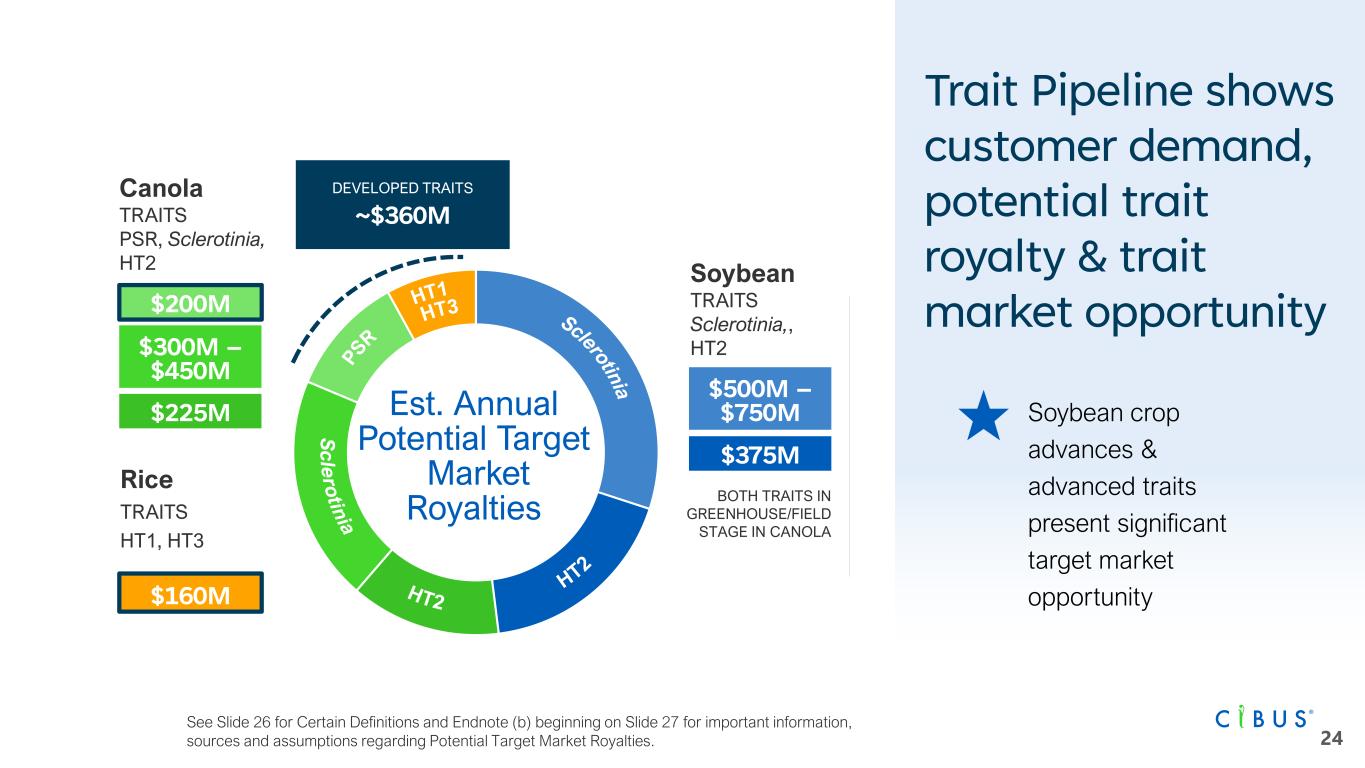
Est. Annual Potential Target Market Royalties DEVELOPED TRAITS ~$360M Canola TRAITS PSR, Sclerotinia, HT2 $200M $300M – $450M $225M Soybean crop advances & advanced traits present significant target market opportunity$160M $375M Rice TRAITS HT1, HT3 BOTH TRAITS IN GREENHOUSE/FIELD STAGE IN CANOLA $500M – $750M Trait Pipeline shows customer demand, potential trait royalty & trait market opportunity 24 See Slide 26 for Certain Definitions and Endnote (b) beginning on Slide 27 for important information, sources and assumptions regarding Potential Target Market Royalties. Soybean TRAITS Sclerotinia,, HT2

$360M Developed Products $2.0B Total 5 Trait Pipeline Cibus’ 5 Trait-3 Crop Model is the Tip of the Iceberg of a New Global Industry Powered by Technology & New Regulations *Regulatory Policy in Place means that gene edited crops are regulated as conventional varieties and not GMOs. Positive Policy Developments means ongoing research regulations are in development but no current timeline or regulatory guidance. Positive Policy Discussions Underway means the regulatory status of gene editing of crops has not been determined. Source: Compiled from information published directly by government authorities as well as industry associations including the International Seed Federation (ISF), CropLife International (CLI), and the American Seed Trade Association (ASTA) and USDA FAS (USDA FAS has a comprehensive country by country list. See: https://crispr-gene-editing-regs-tracker.geneticliteracyproject.org/united- states-crops-food/) This is the Start of a Huge New Industry Global Regulatory Map 25 25
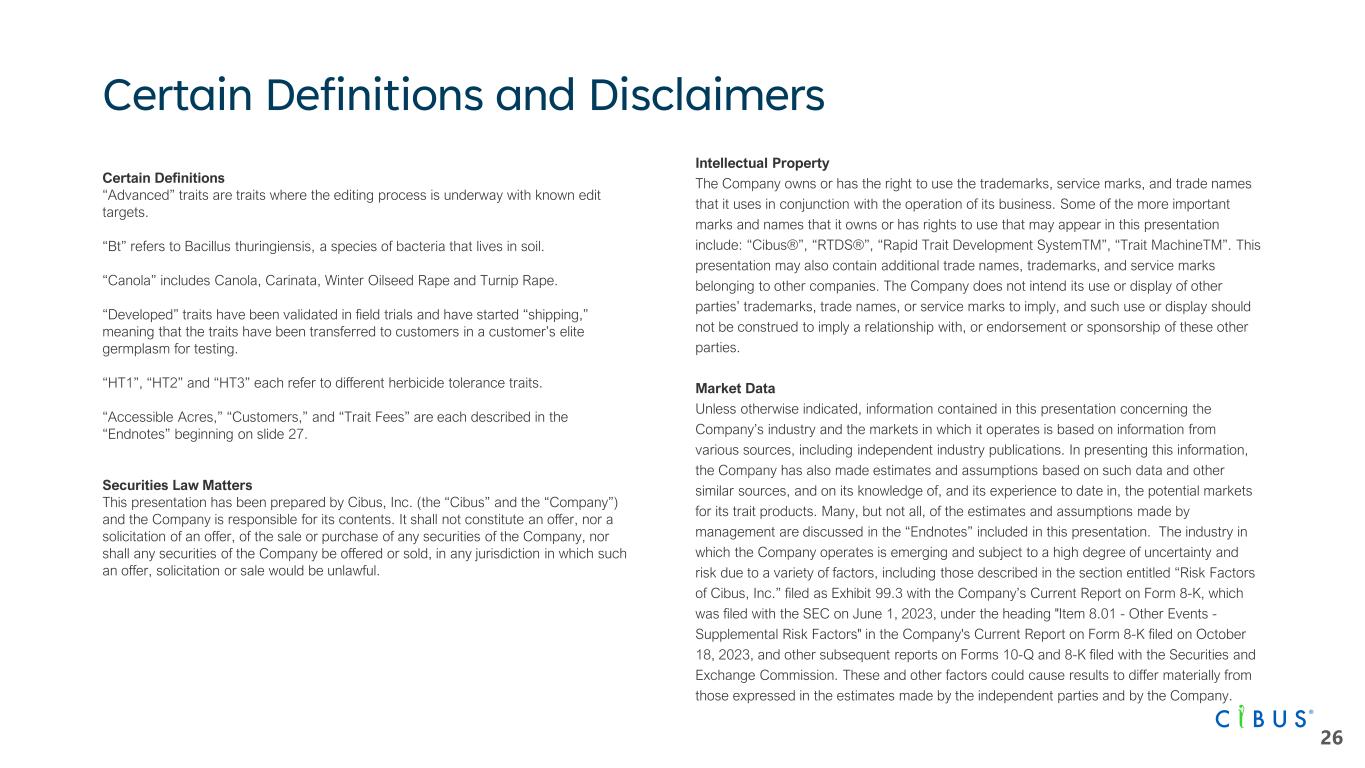
Certain Definitions “Advanced” traits are traits where the editing process is underway with known edit targets. “Bt” refers to Bacillus thuringiensis, a species of bacteria that lives in soil. “Canola” includes Canola, Carinata, Winter Oilseed Rape and Turnip Rape. “Developed” traits have been validated in field trials and have started “shipping,” meaning that the traits have been transferred to customers in a customer’s elite germplasm for testing. “HT1”, “HT2” and “HT3” each refer to different herbicide tolerance traits. “Accessible Acres,” “Customers,” and “Trait Fees” are each described in the “Endnotes” beginning on slide 27. Securities Law Matters This presentation has been prepared by Cibus, Inc. (the “Cibus” and the “Company”) and the Company is responsible for its contents. It shall not constitute an offer, nor a solicitation of an offer, of the sale or purchase of any securities of the Company, nor shall any securities of the Company be offered or sold, in any jurisdiction in which such an offer, solicitation or sale would be unlawful. Intellectual Property The Company owns or has the right to use the trademarks, service marks, and trade names that it uses in conjunction with the operation of its business. Some of the more important marks and names that it owns or has rights to use that may appear in this presentation include: “Cibus®”, “RTDS®”, “Rapid Trait Development SystemTM”, “Trait MachineTM”. This presentation may also contain additional trade names, trademarks, and service marks belonging to other companies. The Company does not intend its use or display of other parties’ trademarks, trade names, or service marks to imply, and such use or display should not be construed to imply a relationship with, or endorsement or sponsorship of these other parties. Market Data Unless otherwise indicated, information contained in this presentation concerning the Company’s industry and the markets in which it operates is based on information from various sources, including independent industry publications. In presenting this information, the Company has also made estimates and assumptions based on such data and other similar sources, and on its knowledge of, and its experience to date in, the potential markets for its trait products. Many, but not all, of the estimates and assumptions made by management are discussed in the “Endnotes” included in this presentation. The industry in which the Company operates is emerging and subject to a high degree of uncertainty and risk due to a variety of factors, including those described in the section entitled “Risk Factors of Cibus, Inc.” filed as Exhibit 99.3 with the Company’s Current Report on Form 8-K, which was filed with the SEC on June 1, 2023, under the heading "Item 8.01 - Other Events - Supplemental Risk Factors" in the Company's Current Report on Form 8-K filed on October 18, 2023, and other subsequent reports on Forms 10-Q and 8-K filed with the Securities and Exchange Commission. These and other factors could cause results to differ materially from those expressed in the estimates made by the independent parties and by the Company. Certain Definitions and Disclaimers 26

(a) Following greenhouse trait validation, field trials are generally conducted using customer-specific germplasm lines. “Years of Field Trials” indicate field trial years in which crop progressed to physiological maturity. Sclerotinia Resistance is a multi-mode of action (MOA) trait, meaning that the trait operates through gene edits addressing multiple cellular processes or physiologies that are affected by the disease. For Sclerotinia Resistance, years from edit to initial field trial is measured for each MOA as an independent trait with this chart presenting measurement for Canola in respect of the initial MOA. (b) Potential target market royalties are (i) management’s estimates of Accessible Acres, times (ii) management’s estimate of the Trait Fee for the specific trait for a specific crop in a specific geography. They are calculated based on management estimates and assumptions, which are based on industry references and estimates of key data, such as the number of acres or percentage of total acres for which the trait would be relevant or where the applicable crop is impacted such that it would benefit from a specific trait. In each crop for each trait, the Accessible Acres may vary widely based on the trait, crop, geography or need. Cibus’ estimates of potential target market royalties also serves as the Company’s estimate of its peak sales for the specific trait and specific crop. This peak would generally be projected to occur several years after commercial availability of seed containing the applicable trait. Accordingly, such calculations should be considered illustrative and constitute forward-looking statements. “Accessible Acres” represent management’s estimate of the number of total acres for the specified geography on which seed with the specified Cibus trait will be planted, which is based on industry sources or references regarding the need for a specific trait in the specific crop and geography or specific jurisdiction, taking into account assumptions about competition, trait relevance, switching costs and adoption timeframes, and various other factors. Among other assumptions, management includes European Union acres in determining Accessible Acres. However, access to European Union acreage is dependent upon a favorable outcome of the EU legislative process with respect to a currently pending proposal. There can be no assurance that such a favorable outcome will be achieved. (continued on next slide) 27 Endnotes
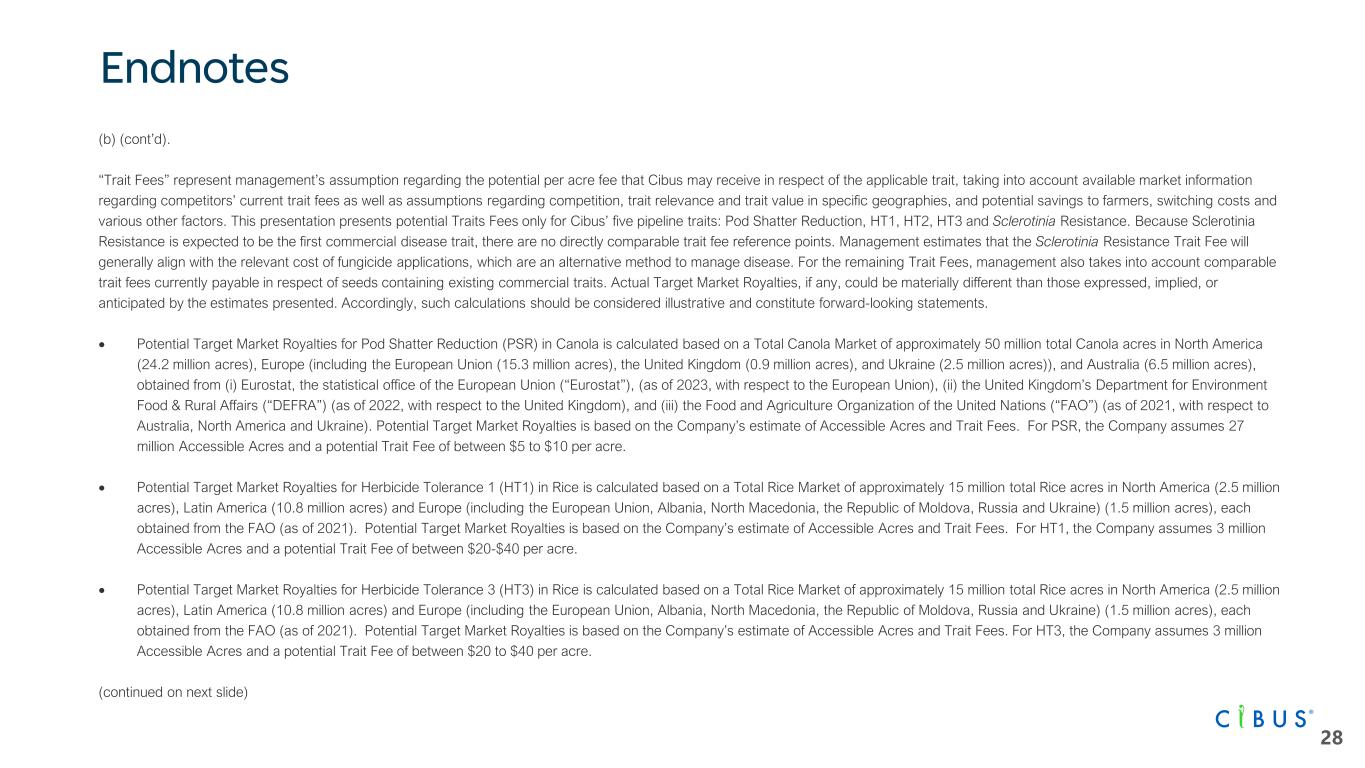
(b) (cont’d). “Trait Fees” represent management’s assumption regarding the potential per acre fee that Cibus may receive in respect of the applicable trait, taking into account available market information regarding competitors’ current trait fees as well as assumptions regarding competition, trait relevance and trait value in specific geographies, and potential savings to farmers, switching costs and various other factors. This presentation presents potential Traits Fees only for Cibus’ five pipeline traits: Pod Shatter Reduction, HT1, HT2, HT3 and Sclerotinia Resistance. Because Sclerotinia Resistance is expected to be the first commercial disease trait, there are no directly comparable trait fee reference points. Management estimates that the Sclerotinia Resistance Trait Fee will generally align with the relevant cost of fungicide applications, which are an alternative method to manage disease. For the remaining Trait Fees, management also takes into account comparable trait fees currently payable in respect of seeds containing existing commercial traits. Actual Target Market Royalties, if any, could be materially different than those expressed, implied, or anticipated by the estimates presented. Accordingly, such calculations should be considered illustrative and constitute forward-looking statements. • Potential Target Market Royalties for Pod Shatter Reduction (PSR) in Canola is calculated based on a Total Canola Market of approximately 50 million total Canola acres in North America (24.2 million acres), Europe (including the European Union (15.3 million acres), the United Kingdom (0.9 million acres), and Ukraine (2.5 million acres)), and Australia (6.5 million acres), obtained from (i) Eurostat, the statistical office of the European Union (“Eurostat”), (as of 2023, with respect to the European Union), (ii) the United Kingdom’s Department for Environment Food & Rural Affairs (“DEFRA”) (as of 2022, with respect to the United Kingdom), and (iii) the Food and Agriculture Organization of the United Nations (“FAO”) (as of 2021, with respect to Australia, North America and Ukraine). Potential Target Market Royalties is based on the Company’s estimate of Accessible Acres and Trait Fees. For PSR, the Company assumes 27 million Accessible Acres and a potential Trait Fee of between $5 to $10 per acre. • Potential Target Market Royalties for Herbicide Tolerance 1 (HT1) in Rice is calculated based on a Total Rice Market of approximately 15 million total Rice acres in North America (2.5 million acres), Latin America (10.8 million acres) and Europe (including the European Union, Albania, North Macedonia, the Republic of Moldova, Russia and Ukraine) (1.5 million acres), each obtained from the FAO (as of 2021). Potential Target Market Royalties is based on the Company’s estimate of Accessible Acres and Trait Fees. For HT1, the Company assumes 3 million Accessible Acres and a potential Trait Fee of between $20-$40 per acre. • Potential Target Market Royalties for Herbicide Tolerance 3 (HT3) in Rice is calculated based on a Total Rice Market of approximately 15 million total Rice acres in North America (2.5 million acres), Latin America (10.8 million acres) and Europe (including the European Union, Albania, North Macedonia, the Republic of Moldova, Russia and Ukraine) (1.5 million acres), each obtained from the FAO (as of 2021). Potential Target Market Royalties is based on the Company’s estimate of Accessible Acres and Trait Fees. For HT3, the Company assumes 3 million Accessible Acres and a potential Trait Fee of between $20 to $40 per acre. (continued on next slide) 28 Endnotes

(b) (cont’d). • Potential Target Market Royalties for Sclerotinia Resistance in Canola is calculated based on a Total Canola Market of approximately 50 million total Canola acres in North America (24.2 million acres), Europe (including the European Union (15.3 million acres), the United Kingdom (0.9 million acres), and Ukraine (2.5 million acres)), and Australia (6.5 million acres), obtained from (i) Eurostat (as of 2023, with respect to the European Union), (ii) DEFRA (as of 2022, with respect to the United Kingdom), and (iii) the FAO (as of 2021, with respect to Australia, North America and Ukraine). Potential Target Market Royalties is based on the Company’s estimate of Accessible Acres and Trait Fees. Potential Target Market Royalties is based on the Company’s estimate of Accessible Acres and Trait Fees. For Sclerotinia Resistance, the Company assumes 30 million Accessible Acres and a potential Trait Fee of between $10 to $15 per acre. • Potential Target Market Royalties for Sclerotinia Resistance in Soybean is calculated based on a Total Soybean Market of approximately 250 million total Soybean acres in North America (91.6 million acres), Latin America (153.0 million acres) and Europe (including the European Union (2.5 million acres) and Ukraine (3.3 million acres)), obtained from Eurostat (as of 2023, with respect to the European Union) and from the FAO (as of 2021, with respect to North America, Latin America and Ukraine). Potential Target Market Royalties is based on the Company’s estimate of Accessible Acres and Trait Fees. For Sclerotinia Resistance, the Company assumes 50 million Accessible Acres and a potential Trait Fee of between $10 to $15 per acre. • Potential Target Market Royalties for Herbicide Tolerance 2 (HT2) in Canola is calculated based on a Total Canola Market of approximately 50 million total Canola acres in North America (24.2 million acres), Europe (including the European Union (15.3 million acres), the United Kingdom (0.9 million acres), and Ukraine (2.5 million acres)), and Australia (6.5 million acres), obtained from (i) Eurostat (as of 2023, with respect to the European Union), (ii) DEFRA (as of 2022, with respect to the United Kingdom), and (iii) the FAO (as of 2021, with respect to Australia, North America and Ukraine). Potential Target Market Royalties is based on the Company’s estimate of Accessible Acres and Trait Fees. For HT2, the Company assumes 20 million Accessible Acres and a potential Trait Fee of between $5 to $12 per acre. • Potential Target Market Royalties for Herbicide Tolerance 2 (HT2) in Soybean is calculated based on a Total Soybean Market of approximately 250 million total Soybean acres in North America (91.6 million acres), Latin America (153.0 million acres) and Europe (including the European Union (2.5 million acres) and Ukraine (3.3 million acres)), obtained from Eurostat (as of 2023, with respect to the European Union) and from the FAO (as of 2021, with respect to North America, Latin America and the Ukraine). Potential Target Market Royalties is based on the Company’s estimate of Accessible Acres and Trait Fees. For HT2, the Company assumes the 75 million Accessible Acres and a potential Trait Fee of between $5 to $12 per acre. (continued on next slide) 29 Endnotes
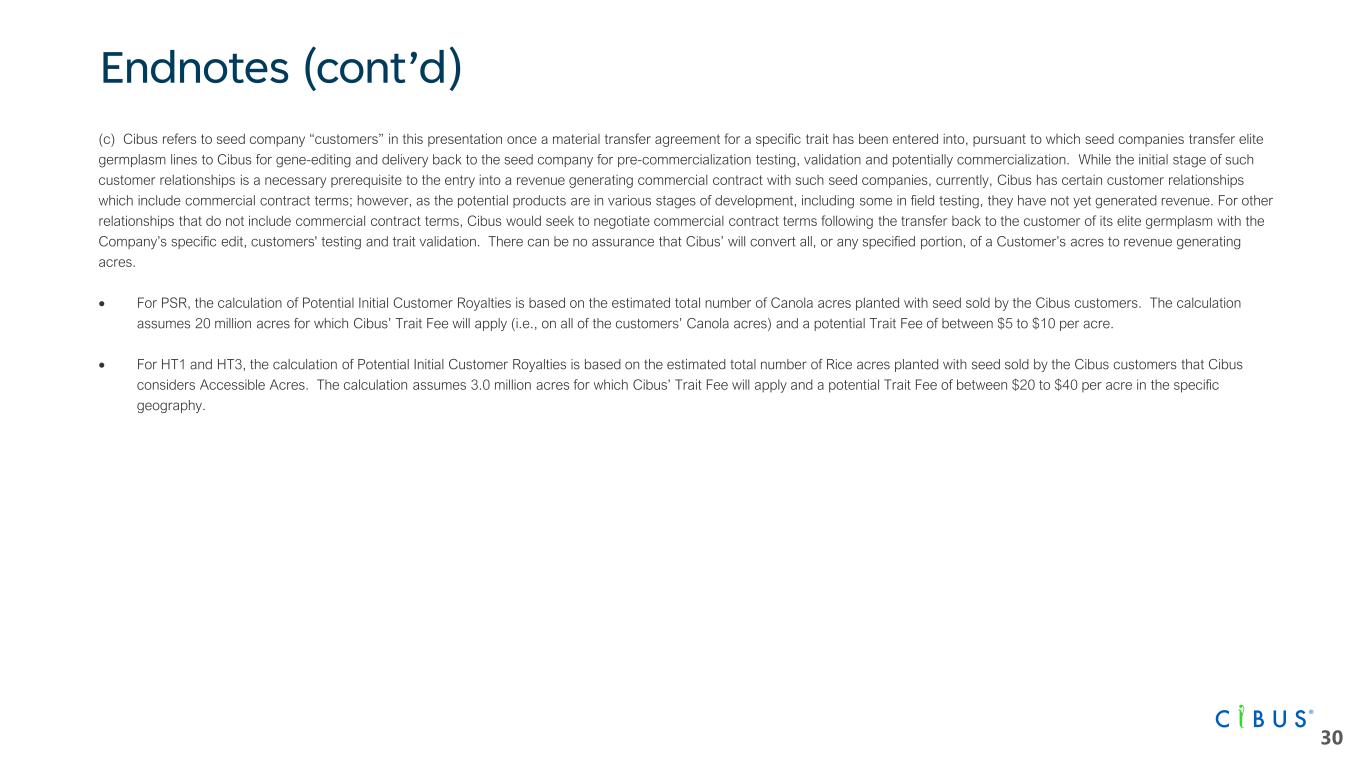
(c) Cibus refers to seed company “customers” in this presentation once a material transfer agreement for a specific trait has been entered into, pursuant to which seed companies transfer elite germplasm lines to Cibus for gene-editing and delivery back to the seed company for pre-commercialization testing, validation and potentially commercialization. While the initial stage of such customer relationships is a necessary prerequisite to the entry into a revenue generating commercial contract with such seed companies, currently, Cibus has certain customer relationships which include commercial contract terms; however, as the potential products are in various stages of development, including some in field testing, they have not yet generated revenue. For other relationships that do not include commercial contract terms, Cibus would seek to negotiate commercial contract terms following the transfer back to the customer of its elite germplasm with the Company’s specific edit, customers' testing and trait validation. There can be no assurance that Cibus’ will convert all, or any specified portion, of a Customer’s acres to revenue generating acres. • For PSR, the calculation of Potential Initial Customer Royalties is based on the estimated total number of Canola acres planted with seed sold by the Cibus customers. The calculation assumes 20 million acres for which Cibus’ Trait Fee will apply (i.e., on all of the customers’ Canola acres) and a potential Trait Fee of between $5 to $10 per acre. • For HT1 and HT3, the calculation of Potential Initial Customer Royalties is based on the estimated total number of Rice acres planted with seed sold by the Cibus customers that Cibus considers Accessible Acres. The calculation assumes 3.0 million acres for which Cibus’ Trait Fee will apply and a potential Trait Fee of between $20 to $40 per acre in the specific geography. 30 Endnotes (cont’d)